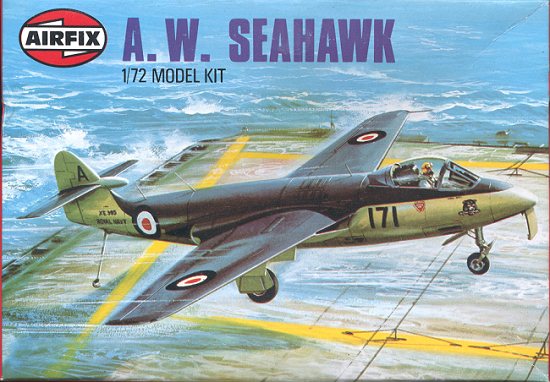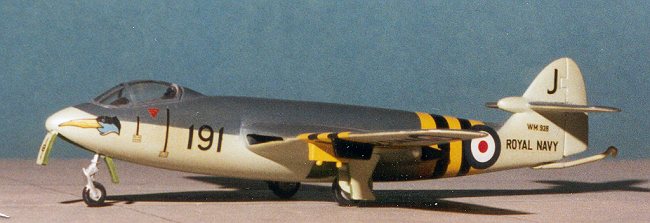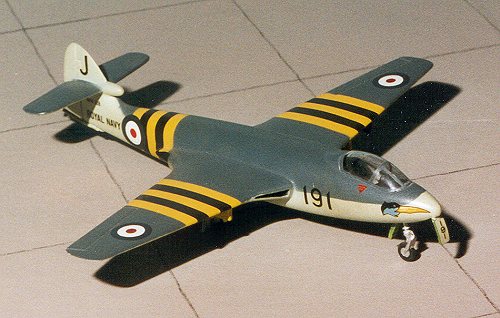

Airfix 1/72 A.W. Seahawk
| KIT # | X-303 |
| PRICE: | $ |
| DECALS: | See Review |
| REVIEW: | |
| NOTES: | Airfix of Japan issue |


| HISTORY |
 The
Sea Hawk WAS derived from Hawker's first jet fighter, the P.1040. This was then
developed into a naval fighter with the first prototype flying on 3 September1948. Designed to replace the Sea Fury and Attacker aircraft on RN Carriers,
the Sea Hawk was of a very conservative design with straight wings and a proven, though thirsty Rolls-Royce Nene turbojet engines.
The
Sea Hawk WAS derived from Hawker's first jet fighter, the P.1040. This was then
developed into a naval fighter with the first prototype flying on 3 September1948. Designed to replace the Sea Fury and Attacker aircraft on RN Carriers,
the Sea Hawk was of a very conservative design with straight wings and a proven, though thirsty Rolls-Royce Nene turbojet engines.
It was discovered that the Sea Hawk was a capable performer, but really not an air combat fighter. For that reason it was developed into an attack fighter. Though a Hawker design, all airframes after the initial 35 F.1swere built by Armstrong-Whitworth.
The Sea Hawk F.1 was followed by the F.2 that had power boosted ailerons. The FB.3 has strengthened wings to handle ordnance. The FGA.4was the first dedicated attack version and was followed by the FB.5 (which were converted F.3 airframes). The final version was the FGA.6, the last of which was delivered in early 1956.
First unit with the F.1 was with 806 Sq in early 1953. It then did the first Sea Hawk deployment on the HMS Eagle. The Eagle, Albion and Bulwark were three carriers that participated in the 1956 Suez War. There were six Sea Hawk squadrons aboard those three carriers. They were: 800, 802, 804,810, 897, and 899 Sq, whose aircraft performed quite capably in the duties assigned. The last Sea Hawk squadron was 806 which was disbanded in late 1960.The type was replaced by the Scimitar.
| THE KIT |
This particular boxing was done in Japan. While identical to the British Airfix kit, the plastic used is avery dark green. Not the best to try to paint over!! It is 60s Airfix at its best. Detailing is raised and petite. The cockpit consists of a seat shape and pilot. A scratchbuilder's dream! There are no boxed in wheel wells. There are also no rivets, nor moveable control surfaces. There are built in weapons pylons on which to put drop tanks and bombs. The drop tanks are quite crude as are the bombs. The tail hook is on a rather large pivot so could be displayed in the lowered position.
 The only option you have is to to a British or German version. The German one has a taller tail. Those of you who have anice stash of decals could do a Dutch or Indian Navy version. The decals in
the kit are for a British FGA.6 from 804 Sq on the Albion and a German Mk.100
from, I believe, MFG 1. The decals are sufficient for the two versions though they areslightly off register, making the roundels in need of replacement.
The only option you have is to to a British or German version. The German one has a taller tail. Those of you who have anice stash of decals could do a Dutch or Indian Navy version. The decals in
the kit are for a British FGA.6 from 804 Sq on the Albion and a German Mk.100
from, I believe, MFG 1. The decals are sufficient for the two versions though they areslightly off register, making the roundels in need of replacement.
| CONSTRUCTION |
When the term 'simple' was developed, this kit was one that was in mind. There are really very few parts to it. However, that does not mean a quick build, even out of the box as this one basically is. The main reason is some questionable fit, mostly dealing with the wings.
However, that is gettingahead of myself a bit, so let's start at the beginning. First thing I did was chuck the pilot. I'm not really fold of them in my kits so dispensed with it. Since this was OTB, all that was installed in the fuselage half was the seat and the tailhook. The cockpit area and seat were painted flat black to cut back on seeing that there isn't anything in there! I put some weight in the nose sectionals it looked to be a tail sitter. Then the fuselage halves were glued together. Some sanding and filler was needed on the seams.
Next is the wing. This is the biggest problem area. The wing roots are two piece assemblies with one piece wings to glue outboard of the roots. The roots not only didn't want to fit well but did not fit to the fuselage at all well. The result is that I used a lot of filler getting the roots to fare in smoothly with the fuselage. Filler was also needed to get the outer wings smoothly attached to the roots.
Then it was on to the tail. As I mentioned earlier, there are two tails, and I used the shorter one for the British version. The horizontal stabilizer with the speed acorn is a single piece and fits atop the shortened tail stub. Then the top of the tail and rudder are glued in place. This went rather well, though some filler was used on the bottom of the stabilizer as I had a bit of a gap to fill.
| PAINT & DECALS |
 At this time,
I decided to start the painting process. The aircraft was to be dark sea grey
over sky with black and yellow Suez bands. The first thing I did was to paint
the band areas white. I always do this first when painting yellow or red. Once
the white was dry, I painted the yellow. At this time in my modeling hobby I was
using Gunze Sangyo acrylics almost to the exclusion of anything else. They are
very nice paints and airbrush very well. Once the yellow had dried the area was
masked off. I was going to use black decal stripes, so made sure that the area
to be masked off was exactly 5 times the width of the stripes I was going tousle. That way, everything will be uniform in width.
At this time,
I decided to start the painting process. The aircraft was to be dark sea grey
over sky with black and yellow Suez bands. The first thing I did was to paint
the band areas white. I always do this first when painting yellow or red. Once
the white was dry, I painted the yellow. At this time in my modeling hobby I was
using Gunze Sangyo acrylics almost to the exclusion of anything else. They are
very nice paints and airbrush very well. Once the yellow had dried the area was
masked off. I was going to use black decal stripes, so made sure that the area
to be masked off was exactly 5 times the width of the stripes I was going tousle. That way, everything will be uniform in width.
Then the undersurface Sky color was painted. When it was dry, those areas needing masking were done so and the Dark Sea Grey was painted over the upper surfaces. There was the usual back and forth painting as I touched up a few areas.
At this time I painted the wheel wells and inside of gear doors chromate green because I didn't know any better! The doors are quite thick so you may consider replacing them. However, they do fit the wells perfectly so doing an in flight display will be rather easy. Then the gear struts were painted aluminum and the wheels black. The nose gear/wheel assembly is one-piece. These were then glued in place so that I could sit the plane on something while doing the rest of the kit.
Once on its gear, I added the black stripes. Those fit very well, however, they couldn't conform too well to the under wing racks. For those I got out the gloss black and hand painted them. The result is convincing.
Now for the decals. The kit ones were not used. Instead, I used a set of ESCI decals for 897 Squadron during the Suez Crisis. Now they offer a much nicer choice than what came with the kit. However, ESCI aftermarket decals seem to be made yellowed and these were no exception. Eventually I ended up only using the fuselage markings minus the roundels. The underwing and tail letters/numbers and all roundels came from various Modeldecal sheets.
The final assembly was the installation of the canopy. It fitquite well and the frames were hand-painted. I did not use any of the underwingstores as they really were not well done at all!
| CONCLUSIONS |
 Despite
the simplicity and slight crudeness of the kit, it remains one of my favorites,
even after all these years. It is just a nice looking aircraft and those Suez
stripes really add a lot to it. Since building this, there have been a few
aftermarket bits for this kit like a vac canopy and metal landing gear from Aeroclub. What is really needed is a cockpit set as there is lots of empty room in there
for one! There is also a 1/72 Seahawk from Frog, but I'm not sure if it is any
improvement over the Airfix version.
Despite
the simplicity and slight crudeness of the kit, it remains one of my favorites,
even after all these years. It is just a nice looking aircraft and those Suez
stripes really add a lot to it. Since building this, there have been a few
aftermarket bits for this kit like a vac canopy and metal landing gear from Aeroclub. What is really needed is a cockpit set as there is lots of empty room in there
for one! There is also a 1/72 Seahawk from Frog, but I'm not sure if it is any
improvement over the Airfix version.
This is a kit that I can recommend for the beginner, mainly because of the few pieces. The more experienced modeler will like it as it gives room for improvement!
| REFERENCES |
British Naval Aircraft since 1912, by Owen Thetford,Putnam, 4th edition, 1978
August 2000
Copyright ModelingMadness.com
Review copy courtesy of me and my wallet!
If you would like your product reviewed fairly and fairly quickly, please contact the editor or see other details in the Note to Contributors.
Back to Reviews Page 2017